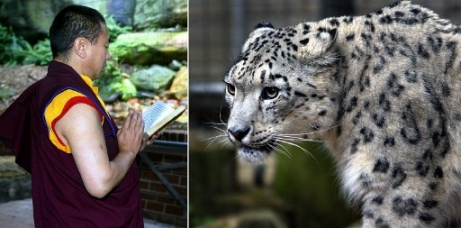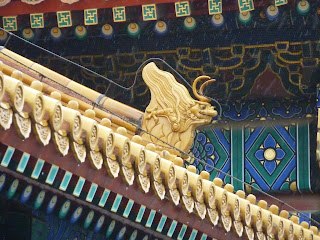Call me a snob tourist.
I go to a place I'm familiar with, Ooty let's say, and look down with
more condescension than is really appropriate at those doing Ooty by the
book. The Lake: check. Botanical gardens: check. Doddabetta: check. The spot where actor x embraced actress y in
film z: check. Tourism by numbers;
tourism by the book; tourism meant to assure your neighbours and relatives that
yes, you saw everything the guidebooks said there was to see.
And so here I was in Beijing. Tiananmen Square: check. The Forbidden City: check. The Great wall: check. And justifying ticking off boxes on a
checklist by the fact that I wouldn't be visiting again anytime soon. But isn't that how everyone justifies by-the-numbers tourism? And isn't there a reason why those tourist
checklists exist?
I'd been to Shanghai, in 2011, to attend a conference. Shanghai isn't a tourist city; it is a place
where people do business. Yes, the Bund
has a series of well-preserved art deco buildings, the Pudong skyline is
something to behold, and the city boasts a fine museum, but a tourist city it
isn't. Even the murky river is a vehicle
for commerce. The city's aesthetics are
all in the service of commerce. Not so
Beijing. And, most emphatically, not so
Xian.
Our flight from Hong Kong was delayed due to bad weather in
Beijing. It was murky when we landed and
we assumed that the weather was responsible.
We learned the next day that the famous Beijing pollution was at least
partly to blame.
Beijing awes with its sheer size and scale, starting with
the airport. We had to take a train to
get from the immigration counters to the baggage claim area, and the ride must
have been a good kilometre or more. The
drive into the city is on broad expressways.
We thought of Chennai and felt like country bumpkins visiting the big
city.
The area around our hotel could have been in any first world
country. Fancy malls, luxury goods
outlets, Audis and BMWs on the streets.
Beijing West Station, though, was large, very crowded and
distinctly second world (unlike the posh and super modern airport). That said, it was functional and, given the
crowds, surprising orderly and clean.
The crowds using the loos are as large as any in India, but the
olfactory assault was much less in evidence.
There was no incentive to search the neighbourhood for a suitable
wall/tree to commit nuisance against.
 |
| The uncrowded platform |
There were trains to various cities in Western China including
Lhasa.
Our train was eventually announced about half an hour prior
to departure and we queued up for another ticket check before being allowed
onto the platform where our train was waiting.
A simple idea this: passengers (and only passengers) are
allowed onto their designated platform a short while before their train
departs. This means that the platforms
themselves are uncrowded, that people can get into trains without pushing and
shoving and, perhaps best of all, that the platforms are clean.
It occurred to me that the station had been designed keeping
this flow of passengers in mind.
Someone, somewhere, had thought about this, perhaps studied stations and
airports both in China and elsewhere (other than India!), and worked out one
way of handling large numbers of passengers.
Our own Central Station, grand edifice though it is, is a
nineteenth century building functioning without alterations in the twenty first
century. While new airports are coming
up around the country, our stations remain firmly anchored in the past.
 Our train, the Z19 non-stop to Xian, was nothing fancy (something
between our 1st and 2nd AC in terms of amenities) but clean, well maintained
and functional. There were friendly nods
from our co-passengers. They spoke no
English, we spoke no Chinese, and, nods done with, we settled down to mind our
own business. The 1200 km was covered
overnight in 11 hours and the ride was smooth; we left exactly on time and got
in to Xian exactly on time.
Impressive. There were no
unscheduled stops: no waking up in the middle of the night to find the train
stationary and the horn blaring plaintively.
Our train, the Z19 non-stop to Xian, was nothing fancy (something
between our 1st and 2nd AC in terms of amenities) but clean, well maintained
and functional. There were friendly nods
from our co-passengers. They spoke no
English, we spoke no Chinese, and, nods done with, we settled down to mind our
own business. The 1200 km was covered
overnight in 11 hours and the ride was smooth; we left exactly on time and got
in to Xian exactly on time.
Impressive. There were no
unscheduled stops: no waking up in the middle of the night to find the train
stationary and the horn blaring plaintively. |
| Our first sight of Xi'an - the old city wall abutting the station! |
 |
| The old and the new |
 |
| Clamped! And on the sidewalk |
Get off these avenues, though, and you enter a different Xian: smaller scaled, more intimate, shabbier and more human. It is a bit like taking a trip back in time, but time measured in decades rather than centuries. You see the Xian of the '80s, then, as you poke your head into a smaller alleyway, the '70s and perhaps even earlier. Little restaurants and shops line the streets, the trees give more shade, there is the occasional bit of broken pavement and uncleared rubbish and there are people standing in the doorways and chatting. Not quite India, but we felt at home.
 |
| Lunch time worker recreation? |
Xian was where the silk route began, and its best known
sights reflect that history. A couple of
kilometres south of the city walls, surrounded by a large granite plaza,
fountains and shopping malls with mock traditional facades, is the Dayan
Pagoda, also known as the Big Wild Goose Pagoda. In the early seventh century, a monk named Hiuen
Tsiang (Xuanzang) made his way along the silk route to Taxila and thence eastward
to Gaya, looking for original Buddhist scriptures. The pagoda was built on his return to house
these scriptures. The 64 meter high
structure would be impressive under any circumstance. The fact that the wherewithal to build
something like this existed 1400 years ago, and the fact that it has survived
wars, earthquakes and the depredations of age make it even more special. Yes, it has been repaired and restored over
the years. But today's structure is, in
essence, what was originally built in the Tang dynasty.
 |
| Our first views, with the newly added fountains |
 |
| The walls of the monastery with added historical carvings |
 |
| Goose bump moment. Here was a connection between India and China |
 |
| The massive bell |
 |
| Equally massive drum |
 |
| The manuscript fragment |
A functioning Buddhist monastery lies adjacent to the
towers. A couple of buildings were being
restored. A fair crowd of respectful
worshippers moved through the buildings, offering incense and prayers at the
numerous altars. Godless communism in
China appears to be increasingly tolerant of religion. Or perhaps it was just another manifestation
of Chinese pragmatism: do whatever it takes to bring the tourists in.
Something had been bothering me as we walked around the pagoda and its surroundings. This clearly was an important structure. Why, then, had it been built well outside the city walls?
We got the answer later that afternoon in the basement of
the Xian museum. A large wooden
reconstruction of the city as it was in the ninth century occupied much of a
large basement room. The city then
boasted more than a million inhabitants and the Tang era city walls enclosed a
much larger area than the surviving Ming era wall.
 |
| As we emerged out of Dayan, this is what we saw! |
Will be continued...






















































Come October, and season begins in Gir, the home of the fabulous Asiatic lion. Zerin Anklesaria was there recently and, thankfully, lived to tell the tale.